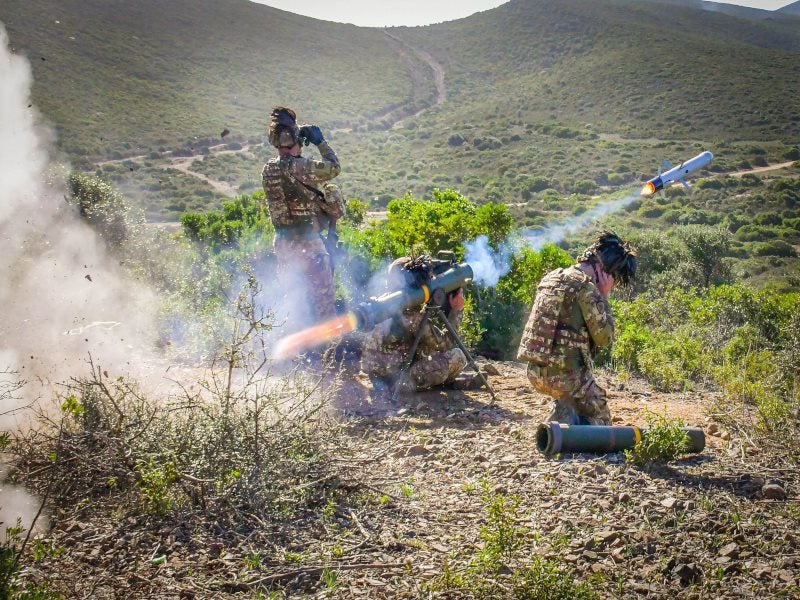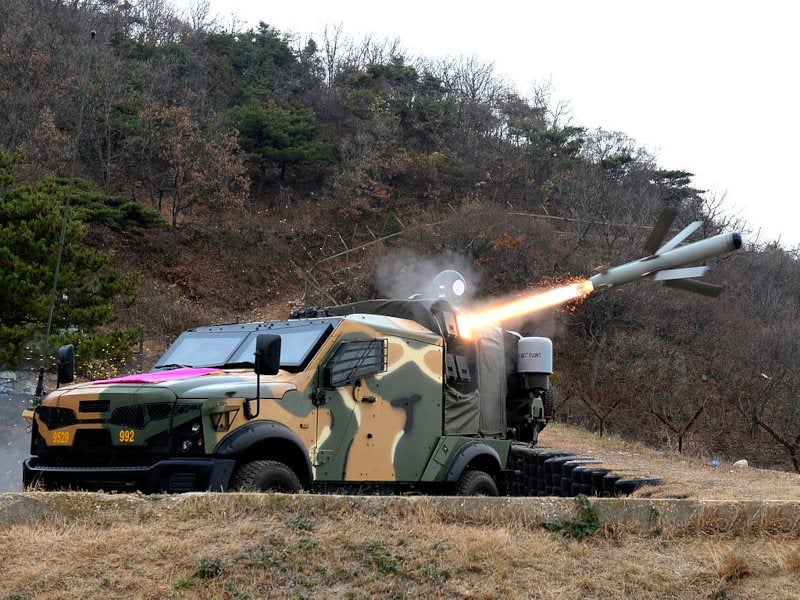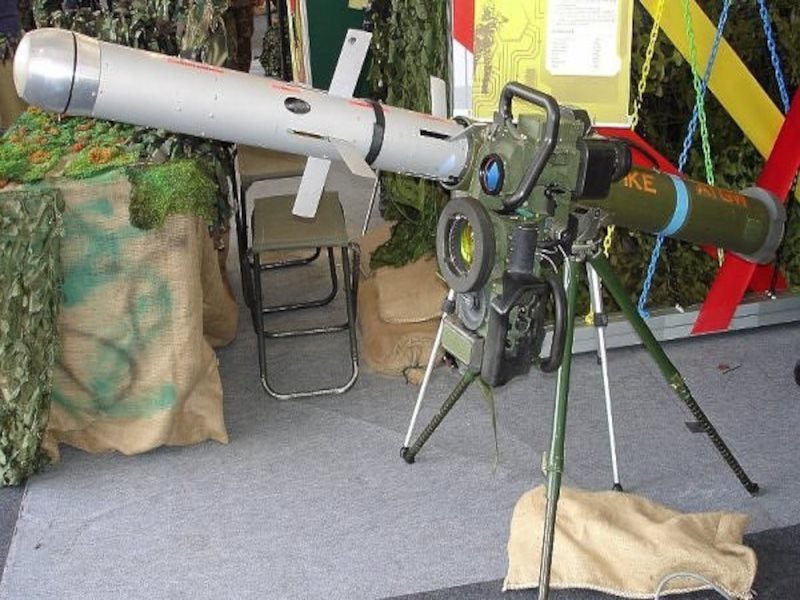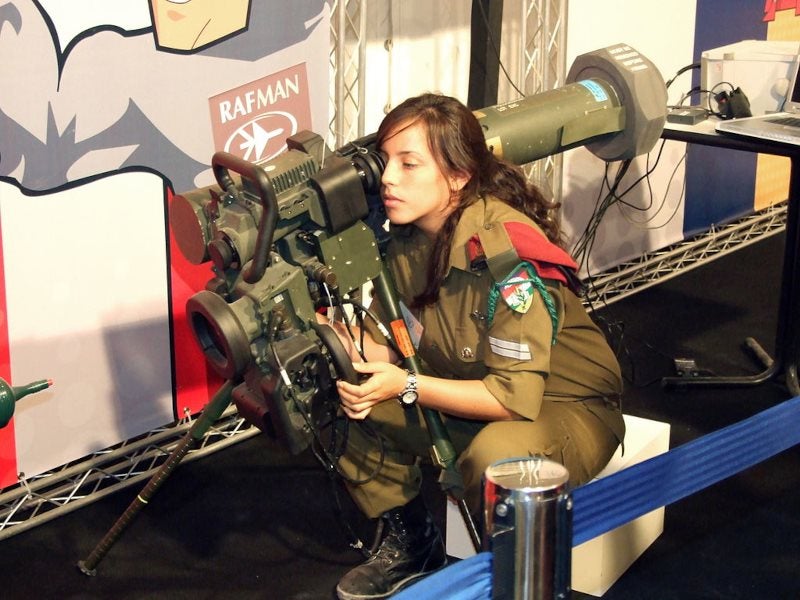The Spike family of anti-tank guided missiles (ATGM) are developed by Rafael Advanced Defense Systems, a defence technology company based in Israel.
These are lightweight, fire-and-forget tactical precision-guided missiles using electro-optical (EO) and fibre-optic technologies. The systems are used by infantry soldiers, special rapid reaction forces, ground forces and helicopter aircrew.
Spike missiles are being used by the defence forces of Israel and another 38 countries, including the Netherlands, Romania, Chile, Colombia, Finland, Germany, Poland, Italy, Peru, Spain, Belgium, Brazil, Canada, Ecuador, Estonia, Lithuania, Latvia, Slovenia, Slovakia, UK, India, Philippines, and Singapore.
Rafael has sold more than 30,000 Spike missiles worldwide, which can be launched from more than 45 different platforms.
Spike anti-tank missile family
The Spike family includes the short-range Spike-SR missile with a range between 50m and 2km, the Spike FireFly miniature tactical loitering weapon with a range between 500m and 1.5km, the medium range Spike-MR (Gill) with a range of 2.5km, and the fifth-generation long-range Spike-LR2 with a range of 5.5km and the extended-range Spike-ER2 with a range between 10km and 16km.
The family also includes the sixth-generation Spike non-line-of-sight (NLOS) missile with a range extended up to 50km from a helicopter and 32km from the ground.
Spike anti-tank missile orders and deliveries
In October 2003, the IDF (Israel Defense Forces) awarded a production contract for Spike C4I, the Spike-ER system fitted with networking capability. The Spike launcher will be fitted with a variant of the Azimuth Comet GPS, laptop computer and VHF datalink.
In June 2004, joint venture company Eurospike was formed by Rafael with Rheinmetall Defence Electronics (formerly STN Atlas Elektronik) and Diehl Defence. This followed a cooperation agreement signed by the three companies in November 1998. Eurospike is the prime contractor for the Spike family of missiles in Europe.
In May 2000, the Finnish Army selected the Spike-MR system to meet its requirement for a medium-range anti-tank missile system. Rheinmetall produced the launchers and warhead, while Diehl produced the munition.
In August 2001, the Dutch Ministry of Defence ordered the Gill missile system to replace the Dragon missile of the Royal Netherlands Army and Marine Corps. Rafael was the prime contractor, with Rheinmetall, Diehl and Thales Nederland (formerly Signaal) the major subcontractors.
In January 2004, Poland signed a contract with ZM Mesko for the purchase of the Spike-LR missile system. ZM Mesko manufactured elements of the missiles and began final assembly in 2006. The requirement was for 264 tripod launchers and 2,675 missiles. Deliveries began in November 2004 and concluded in 2013.
In December 2006, the Spanish government placed an order for 260 launchers and 2,600 Spike-LR missiles, to replace its Milan and Dragon missiles. General Dynamics Santa Barbara had signed a contract with Rafael for local production of the missiles. Deliveries began in 2009. Since then, approximately 236 launchers and more than 2,300 missiles of the LR1 or LR2 model have been received by the Spanish Army.
In January 2008, Spain placed an order for Spike-ER missiles to equip the 24 Tiger HAD attack helicopters on order from Eurocopter, an aviation company based in France. It also intends to buy 168 launchers and 1,680 spike LR2 missiles to replace the Tow missiles used by the Spanish army.
In December 2008, PSM and the German Ministry of Defence signed a contract to integrate the Spike missile system on the Puma armoured infantry fighting vehicle being developed for the German Army.
The German Army signed a multiyear contract with Eurospike to procure Spike anti-tank missiles and launchers in November 2019. The first order included 1,500 Spike rounds and hundreds of Rafael’s new integrated control launch unit dismounted missile launchers.
The Danish Ministry of Defence procured Spike LR2 ATGM systems from Eurospike for the reconnaissance and infantry units of two Danish combat battalions in March 2021.
In September 2021, the Spike LR2 ATGM was selected to arm the vehicles procured under the LAND400-2, LAND400-3 and LAND159 Defence programmes in Australia.
Varley Rafael Australia, a joint venture of Rafael and Australia’s Varley Group, will supply these missiles.
Israel and Greece finalised a $400m deal for the sale of Spike anti-tank missiles in April 2023. The Swiss government selected the Spike LR2 missile for the Swiss Armed Forces in the same month.
Spike anti-tank missile system
Spike-MR and Spike-LR have the same firing post. The firing post consists of the command launch unit (CLU), the thermal imaging sight and a tripod.
The system is made ready to fire in less than 30 seconds. The soldier acquires the target and lays the crosshairs of the sight on the aim point on the target using either the day sight with a 10x magnification and 5-degree field of view or the clip-on thermal imaging night sight with wide and narrow fields of view.
In fire-and-forget mode, the soldier activates the missile, locking the tracker on the target and pushes the fire button to launch. The missile automatically propels itself towards the target without any additional interaction and this fire-and-forget capability allows the soldier the option of relocating to a new firing position or to reload immediately for the next engagement. Reloading takes less than 15 seconds.
After launch the missile follows a lofted trajectory and as it approaches the target it dives down to impact the target. The lofted trajectory and the tandem high explosive warhead enable the missile to penetrate tanks equipped with explosive reactive armour.
Anti-armour missile
The missile has four rectangular fins for aerodynamic control at the rear, and four wings at just over halfway from nose to tail on the length of the body. They unfold as the missile leaves the launch canister.
The guidance system in the nose of the Spike missile comprises a charge-coupled device and imaging infrared seeker. The imaging infrared provides higher sensitivity and improved thermal background rejection characteristics for all-weather day and night operations.
Gill medium-range anti-armour missile
Spike-MR, the medium-range version, is a portable fire-and-forget anti-armour missile system with a range up to 2.5km. It can have the option of the additional fire, observe and update mode of operation if required.
Spike-LR long-range anti-armour missile
Spike-LR is a portable anti-armour weapon system with a range of up to 4km, which can be operated in fire-and-forget mode and in fire, observe and update mode using the fibre-optic data link.
Spike-LR is equipped with a fibre-optic data link guidance system, which sends commands to the missile from the launch system and receives, into the gunner’s field of view, images from the seeker. The gunner can update his aim point while the missile is in flight using the fibre-optic link. As well as updating target information, the datalink allows the gunner to switch targets and also receive real-time intelligence and perform battle damage assessment. The Spike system can work in NLOS mode allowing the gunner to operate from a covered position.
Spike-LR, which can also be installed on light combat vehicles, can be used to engage tanks, armoured vehicles, hardened shelters and low-flying slow targets such as helicopters.
Spike-ER extended-range anti-armour missile
The extended-range (8km) version, Spike-ER, also has a larger warhead. It is designed for mounting on light combat vehicles but can also be removed and fitted onto a tripod. The vehicle package includes the missile in its canister, a remotely controlled turret with target acquisition system and electronics and gunner’s station with multifunction display, control panel and handgrip.
A bidirectional fibre-optic datalink provides Spike-ER with a fire and steer mode, in addition to the other two modes. This means that the gunner does not need to lock-on to the target before launch but can choose the target after launch and steer the missile to the target’s most vulnerable point or hand over to fire-and-forget.
Rafael has developed a version of Spike-ER with a penetration, blast and fragmentation warhead which only explodes after penetration of the target, such as a wall, minimising collateral damage.
A Spike-ER launcher has been developed for helicopters. The four-round launcher requires no modifications to the helicopter, other than software integration. It can be fitted to a variety of helicopters, including AH-64 Apache (which can carry 16 missiles), AH-1S Cobra, A-129, MD-500, Mi-24 and others.
Spike-LR2 and Spike-ER2 details
The Spike LR2 is a fifth-generation, multiplatform long-range missile system which can be used by infantry, armoured vehicles, naval vessels and helicopters. It has a higher hit probability and enhanced lethality against all types of targets. The reduced weight enables carrying two rounds by one soldier.
Spike ER2 is a fifth-generation, EO-guided missile system with an extended stand-off range. Weighing 34kg, the system has a powerful tandem high explosive anti-tank warhead or penetration-blast-fragmentation capabilities for anti-structure and anti-ship missions. It also features high-resolution infrared and day sensors and very high armour penetration capabilities. It offers rotary dominance, ground, air and maritime overmatch and deterrence.
The systems are immune to radio frequency, GPS and other jamming measures and have selectable flight trajectories, offering low, medium and high angles of attacks and mid-flight abort mission capabilities.
Spike NLOS non-line of sight missile
The sixth-generation Spike NLOS, multiplatform EO attack missile can be fired from land, air and naval platforms. Equipped with a range of warheads and RF communications, the missile can be deployed in both offensive and defensive scenarios.
The system is designed to complete the sensor-to-shooter cycle efficiently and eliminate multiple targets from significant distances.
With real-time tactical information and battle damage assessment, it allows for target modifications and the option to abort missions during flight.
Mantis fast attack vehicle mounted Spike-LR
A prototype of the Spike-LR missile mounted on a Marvin ITV-14×4 all-terrain vehicle was built by Rafael. The system is called Mantis and consists of six Spike-LR missiles with the Rafael Spike C3I system and reconnaissance sensors, including CCD day camera, thermal imager, laser rangefinder and GPS.







